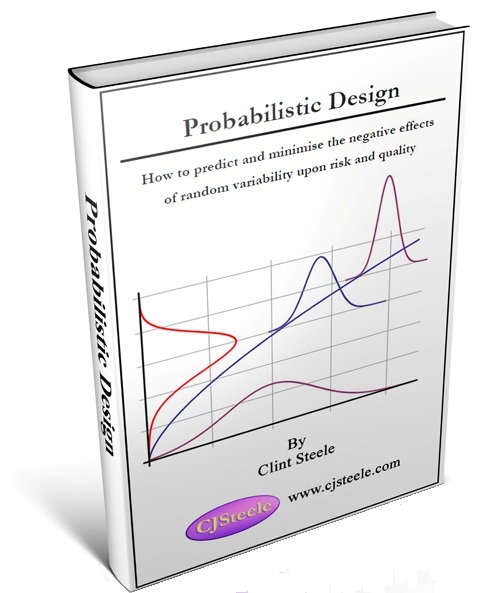Description
So many of us work in areas where random variability is the major source of the issues we need to deal with: quality, risk, reliability. But how many of us really understand the key to analysing random variability: Probabilistic Design?
I am sure that you have heard of Six Sigma, Value Analysis, Value Engineering, Quality Circles, Quality Function Deployment, Design of Experiments, Failure Mode and Effects Analysis, Fault Trees, SWOT, Facilitated Risk Analysis Process and many other similar systems that have been and gone.
But let me ask you this. Do you really understand how these systems actually optimise so that the negative effects of random variability are reduced or eliminated?
How can it be that we all spend so much time working in an area imbedded in probabilistic issues and yet we know next to nothing about probabilistic design?
Well I think it’s because of the influence of Taguchi and the current domination of quality and risk by statisticians. My PhD supervisor told me about an argument that he had with Taguchi over the application of basic probabilistic methods: Taguchi rejected anything that wasn’t experimentally based. Statisticians too also rely almost solely on an experimental approach. On the other hand, probabilistic design uses your knowledge and expertise so that you can quickly and easily design robust systems without the need for time consuming experiments.
If you have seen the about page, then you know how much time and effort I have put into understanding the application of probabilistic design to robustification and how important I think they both are to someone like you.
I have been researching, teaching and applying probabilistic design for years, and during this time I have learnt three things:
Applying probabilistic methods can often break your focus on designing or planning, and this makes it hard to properly integrate them into your work.
When you use them enough and learn them in the right way, probabilistic methods become intuitive. They are then easy to apply, and you can then easily integrate them with your other skills and the rest of your knowledge.
No one seems to explain or teach probabilistic methods in a way that quickly lets people apply them intuitively. I actually believe that no one has ever even thought to do this.
Because I know how powerful probabilistic methods are and how important they are for robust design, I think everyone should know how to apply them intuitively. The only trouble I noticed is that no one seemed to teach this.
That’s why I wrote this e-book. It condenses what I have learnt over 10 years into a single book for you. Not only does it summarise what I know, but it also focuses only on what you really need to know. Everything that is just excess or mild academic interest is removed. I have only included what I have found to be actually useful to developing a practical and useful ability in probabilistic design.
Even more importantly, it focuses on developing your practical skills. Instead of just covering abstract theory, and hoping that somehow you figure out how to apply it on your own. That’s what makes it different from the other books on the topic of robust and probabilistic design that I bought and read over the years. I have developed this e-book over years while teaching people how to actually apply probabilistic methods for robust design, and it is with this focus on the application of probabilistic design that the e-book was written.
Once you read my e-book and learn what’s in it, you will be able to naturally design robust systems: systems with high quality and low risk. You will also finally have a true and proper understanding of both robustness and probabilistic design.
So download the e-book now and learn the key to robust design that you just won’t learn anywhere else. You can learn from my experiences teaching and practicing probabilistic design to improve quality and risk in systems that are affected by random variability.
Do you know why you should have a mastery of probabilistic design?
Imagine the feeling that comes with:
Naturally designing your system to be immune to random variability
Identifying systems that will be inherently unreliable so that you can avoid them
Being the one that everyone asks when randomness is causing them a near incomprehensible quality, risk or reliability problem
Designing a product so durable that it operates perfectly even after parts have worn
Spotting risk and quality issues before they cause any real problems
Properly understanding what robustification is and how it actually works
Being able to use probabilistic design theories to explain quality and risk issues to anyone
Knowing that you can spot and avoid high risk systems
Quickly understanding quality problems when others are just stressed and trying to work out what is happening
Listening to someone talk about the latest quality practice when you know the real fundamental phenomena that make this ‘new’ method work
People looking at you like you’re a magician as you look into a problem imbued with randomness and find the answer. This is my favourite; something about probabilistic methods just impresses people.
I can do all of these things so I can tell you that it feels great when that mystery that many of us associate with random variability is gone.
Quality problems disappear
Risks are quantified and accounted for
You can focus on development, and not worry about uncertainties
You are so much more confident when you are developing systems. You know that they will be robust and produce no quality, reliability or risk issues.
Additionally, you can pre-empt potential issue before they happen and then quickly resolve them in the later developmental stages.
Probabilistic design is not as magical as it seems!
I know that everyone seems to think that the application of probability theory is borderline magic: I see it all the time in my work.
However, I also teach probabilistic methods. I always see how once you get a few key points and let go of the irrational fear that many seem to have of probability and statistics, you can quickly master probabilistic methods.
Anyone can master probabilistic design.
And, because of the benefits that come from being able to intuitively incorporate it into your everyday work, I think everyone should have a chance to learn how.
The only problem is that a lot of people who teach this stuff seem to want to make it hard. They either focus on such intense theory at the start that they kill your desire to learn or they give no thought to making it easy to learn.
I think it should be made as easy as possible for you to be able to learn how to intuitively apply probabilistic methods. And that’s been my goal for the past few years, and it is something that I want to share with you.
How to develop an intuitive ability to apply probabilistic design methods
So what is the secret to having this intuitive understanding that lets you have this ability?
It is actually a bit paradoxical. In fact, it reminds me a bit of a quote that I once heard from a Tango Argentino dance teacher:
You need the logic before you can have the passion.
In the context of dance it means you need to understand music and the moves before you can use them intuitively to guide your actions on the dance floor in a passionate dance.
It might seem like a stretch, but it I found that it is exactly the same with probabilistic design. You first need to work with the logic so that you not only see how it works, but so that you have applied it too. This way you can ‘feel’ how it works. Once you have a feel for how it works and you combine this feeling with the logic, it becomes intuitive, and easy, to use probabilistic methods whenever you are analysing or designing a system.
That’s why I have written this e-book: to help you naturally and intuitively incorporate probabilistic methods into your everyday activities.
How will this e-book teach me to intuitively apply probabilistic methods?
The e-book that I have written shows you how to most easily develop this logic and then the feel so that you can have an intuition for probabilistic design. I have written it strategically to develop your intuition:
First I make you think about the problems you face in the most suitable way.
Then with your mind open to receive the information I show you how you can use probabilistic design methods to solve such problems.
By seeing how these problems are solved with such methods you begin to see, understand and feel how probabilistic design works.
With this, you then begin to develop your intuitive ability.
I have done this for hundreds of students so I know that I can do it for you too.
Inside the e-book you will learn:
The mindset that only a few people have, but that you can develop to make it easy to intuitively apply probabilistic methods (Page 3).
When robustification is impossible (Page 8 and Page 58) there are two reasons
When experimental procedures can cause problems (Page 78). Interestingly enough, the problem is the ultimate benefit.
How you can determine how much information you really need to predict quality (Page 40)
A graphical method that allows you to see how random variability flows through a system (Page 22)
Why many people actually don’t know how to properly use control charts, but you will (Page 43)
The limitation with a common quality control method that few really know about (Page 44)
The probabilistic theory that underlies a number of quality methods that no one ever seems to tell you about (Page 6)
An old, but rarely known method for optimising a system that is easier than traditional DoE methods (Page 103)
The potential Achilles heal with Six Sigma (Page 41)
How to properly understand the need for a well designed experiment (Page 64)
An improved experimental method for robustifying a design that reduces workload and gives you much more insight into your system (Page 88)
Techniques you can use to quickly and easily model a system so that you can see how random variability will affect quality and risk (Page 92)
The principle that actually allows robustification to work (Page 7). Once you have this, everything else just falls into place.
How to visualise experimental design to see sensitivities there could be to small measurement errors (Page 69)
About some of the best books that I have come across on the topic of probabilistic design (Page 114)
The algebra of probability distributions that are a mystery to most, but so vitally important to those of us who need to ensure quality and risk (Page 15)
How to reduce the workload that comes with experimental methods (Page 62). Most people always waste far too much time on these
How to estimate random variability of key features when you have limited data (Page 17)
How to use initial findings to see if you have improved a system’s reliability without the need for extensive testing (Page 101)
The benefits to be had from inverting variables in experiments (Page 84)
How you can quickly analyse the results of experiments in Microsoft Excel, without the need for costly DoE software (Page 90)
How Monte Carlo works and where you can gat a simple Microsoft
Excel application for free (Page 18)
About the use of genetic algorithms in robustification, and you can bets work with them (Page 51)
About the numerous ways you can optimise a system in the spreadsheet environment (Page 59)
How a common habit that many of have can be destroying you ability to intuitively design more robust systems and what to do about it (Page 93)
A collection of short hand equations that you can use to help you follow the flow of random variation through a system (Page 34).
How you can simplify a system so that you can more easily analyse it for quality and risk (Page 94)
Creating actual probability distribution with small data sets (Page 99)
Some of the best ways to properly quantify and describe random variables (Page 13)
Don’t get me wrong, it’s not like I am going to just hypnotise you and pass the information in subliminally. It will take some time for you to develop this intuition and you will need to have an understanding of the logic.
However, I have laid the book out so that the logic comes easily and the intuition naturally develops. Just as I have seen it happen time and time again with others before you.
What should you do now to improve your probabilistic design skills?
I have spent years working in this area and teaching it.
That’s why I am so certain that this e-book will help you. In fact, I am so certain that if you feel it doesn’t help you, then I will give you your money back. No questions asked I will return your money.
I am only interested in helping you and if you feel I haven’t helped you, then I need to try something else, and you shouldn’t have to pay for what didn’t work.
That means you really have nothing to lose!
So if you want to improve your probabilistic design skills, and be able to design robust systems (like products, manufacturing operation and business plans) instinctively, then hit the buy button below and download the e-book now.
If you are still not sure about the e-book, and I can understand that because this is new to a lot of people, then for free you can take a look at the first four chapters. These are the most critical and will give you the beginnings of the intuition that I have spoken about.
You might find that this is all you need.



















